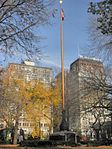Statue of the Marquis de Lafayette (New York City)
1876 establishments in New York (state)1876 sculpturesBronze sculptures in ManhattanCultural depictions of Gilbert du Motier, Marquis de LafayetteMonuments and memorials in Manhattan ... and 9 more
NRHP infobox with nocatNew York (state) sculpture stubsNew York City stubsOutdoor sculptures in ManhattanSculptures by Frédéric Auguste BartholdiSculptures of men in New York CityStatues in New York CityStatues of military officersUnion Square, Manhattan

Marquis de Lafayette is an outdoor bronze sculpture of Gilbert du Motier, Marquis de Lafayette by artist Frédéric Auguste Bartholdi, located at Union Square Park in Manhattan, New York.
Excerpt from the Wikipedia article Statue of the Marquis de Lafayette (New York City) (License: CC BY-SA 3.0, Authors, Images).Statue of the Marquis de Lafayette (New York City)
Union Square East, New York Manhattan
Geographical coordinates (GPS) Address External links Nearby Places Show on map
Geographical coordinates (GPS)
| Latitude | Longitude |
|---|---|
| N 40.73568 ° | E -73.98997 ° |
Address
Marquis de Lafayette
Union Square East
10003 New York, Manhattan
New York, United States
Open on Google Maps









